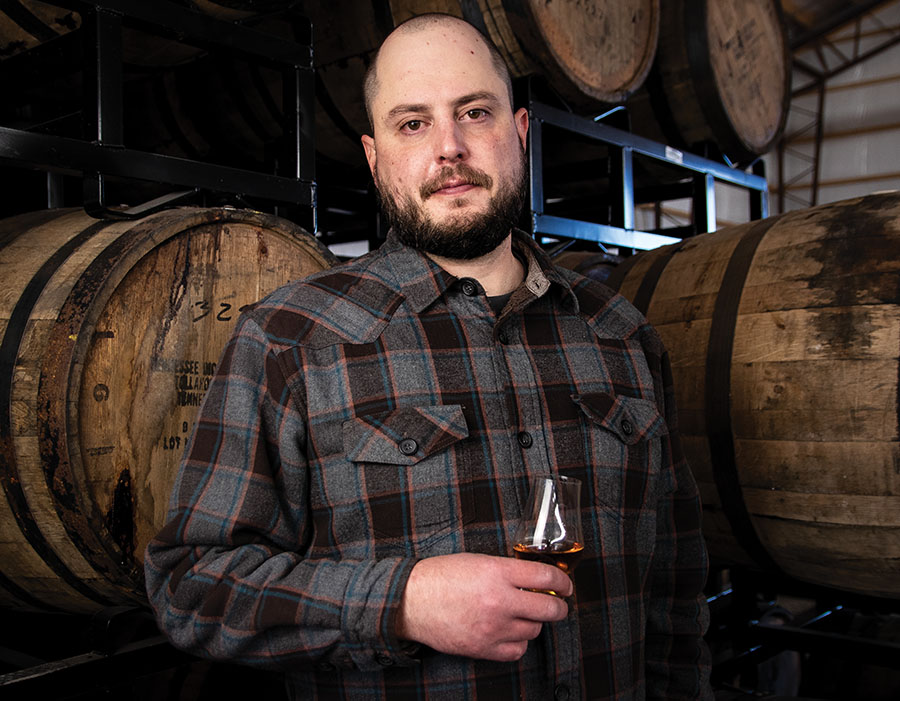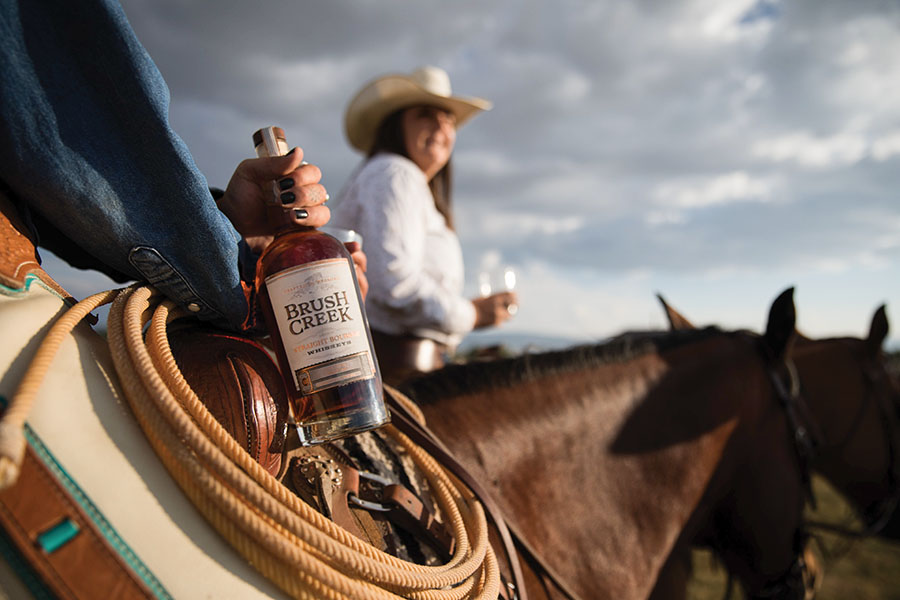For 126 years, the John Bunning Transfer Station has stood where cold rails meet a spur of mountains rising from the hardened steppe of southern Wyoming. Over the generations, it’s seen its share of boxcars bringing whiskey to fuel the sturdy saloons in nearby Reliance or on the outskirts of Sweetwater County. Yet, when a large shipment of barrels arrived in the spring of 2021, something seemed a little out of time — it was like a steam-driven ghost from the past was returning to the station.
To start with, this whiskey loot was chugging into town on a Union Pacific 60-foot sideload railcar. The John Bunning crew hadn’t seen one of those come through the yard in ages. The barrels had also been trekked to this corner of Wyoming on the historic path of the Transcontinental Railroad, the one-time engineering marvel that brought resources from the frontier to economic power hubs of the East. The line’s creation had broadened the entire scope of American possibilities.
Students of the period know that transcontinental accomplishment didn’t come without sacrifice. The men who chiseled granite slopes by hand, scurried from dynamite on cliffs by rope, or carried nitroglycerin through dark caves all faced real and constant dangers. Even with less extreme tasks, blizzards, rockslides, deadly temperature dips, and miscalculated explosions routinely threatened the lives of the mostly immigrant workforce.
For Andrew Wason and Philip Mundt, the the personalities behind Brush Creek Railroad Rye, the tracklayers who toiled through those hazards are emblematic of all of the hardscrabble pathfinders who forged new communities out West, from the steer-herding pens of Nebraska to the industrial gold mines of California. That’s why the partners wanted the first whiskey produced by their distillery on a 30,000-acre Wyoming cattle ranch to be tied to that pioneering legacy of the near-impossible rail line.

In making their rye, Wason and Mundt had a collection of hand-selected mature whiskey barrels brought from southern Indiana on a 1,200-mile train trip that followed the path of the Transcontinental Railroad. At the John Bunning Station, it was moved by truck to the 7,600-foot elevation mark of Brush Creek, where the spirits were finished amidst the unpredictable Wyoming weather. All of this was part of Wason and Mundt’s mission to breathe some of the history that their rye represents directly into its own maturing process. Other distilleries have made similar attempts, some sending barrels out to sea, others driving them down the bends and turns of famous American highways. For Wason, overcoming all of the obstacles that came with Railroad Rye’s great journey was worth it in the end.
“I think it’s really about telling the story of the American West through a great bottle of whiskey that we put together,” he explains. “We say that it’s celebrating that legacy based off the fabric of the railroad.”
An Easy Drink for a Hard Land
In 1865, the Central Pacific and Union Pacific railroad companies began laying tracks across rough terrain, moving toward each other from opposite coastlines. The Central Pacific was relying largely on Chinese immigrants who had ventured out to the California Gold Rush, while the Union Pacific had mustered an army of Irishmen who had escaped the deadly famine in their homeland.
The Chinese workers developed a reputation for avoiding whiskey throughout the toil and travail. The Irish absolutely did not: Whiskey-making had been a tradition on the Emerald Isle since the 1750s; for those railmen it helped not only numb the constant body aches, it provided a spiritual portal back to the villages of their youth. After the hammering of the ceremonial golden spike that completed the Transcontinental Railroad in May of 1869, homesteaders from the East began staking out new futures in the West. They, too, would run into daunting challenges — and many would use whiskey as a way to comfort and heal the soul.
Such stories were common in Rock Springs, Wyoming, the town where the John Bunning Transfer Station sits. After Wason and Mundt’s whiskey shipment arrived there, the barrels were loaded onto trucks before getting hauled another 150 miles to Saratoga in central Wyoming. There, they were taken onto the sweeping territory of Brush Creek Ranch near the Medicine Bow National Forest.

Established just 19 years after the Transcontinental Railroad was finished, the ranch is now more than a working cattle operation. An all-inclusive getaway resort, it has restaurants, shopping, a sustainable greenhouse, a brewery, and a wine cellar. A few years ago, its ownership decided it would really benefit from a distillery.
Wason, who’s originally from Louisville, Kentucky, was tapped because of his extensive marketing background in the wine and spirits industry. Mundt, on the other hand, is a westerner out of Colorado who learned distilling at Stranahan’s Whiskey, where he worked his way up to head of production. When Wason and Mundt first started on Brush Creek’s distillery, they noticed that Wyoming was celebrating the 150th anniversary of the Transcontinental Railroad. The city of Cheyenne had even sent out one of its historic train engines to re-create a part of the journey to the spot where the golden spike was driven. All of that made the two distillery upstarts want to lean into the white-knuckle fortitude of the land that they were working on.
They had a novel idea, yet quickly realized it wasn’t going to be easy to execute.
“The anniversary really created an opportunity for us to piggyback on that momentum and have some fun,” Wason recalls, “but we had to petition the Union Pacific Railroad three times — they were not keen on the idea of putting full barrels of whiskey on the sideroad rail car.”
After working through shipping and safety logistics with Union Pacific, the John Bunning Transfer Station and Grand Warehouse in Chicago, Illinois, the team at Brush Creek finally had the green light for their ambitious concept.
“It was just a lot of people involved in making it happen after we finally got an approval process,” Wason stresses. “It was no small feat, but I think it’s showcased in the finished product.”
Whiskey Barrels That Roll, Crest, and Shake Through the World
As the intersection between spirit production and strands of American history has become an intriguing idea to whiskey fans, some distilleries have looked for ways to infuse those connections straight into their finishing processes. In 2014, 8th-generation Kentucky distiller Trey Zoeller unveiled a release from Jefferson’s Ocean, which came from whiskey barrels he had put out to sea for three years on a shark research vessel. Zoeller told reporters this was a way of “going back to how bourbon was initially aged” in colonial times. He also said that, after traveling south of the equator and through the tropics, the bourbon that had gone into the barrels clear had eventually come out with dark color and intriguing flavor profiles.
Last year, WhistlePig used similar finishing tactics with its Roadstock Rye, which involved putting 40 barrels of whiskey on an 18-wheeler and then sending them for a 6,000-mile odyssey along the famous Route 66. WhistlePig’s team maintains that the way the barrels were sloshing during this ride added to the uniqueness of what was eventually bottled.

For his part, Mundt is not really emphasizing the train ride’s literal effect on Railroad Rye. He tells people who are trying the whiskey to think of the train journey as mostly symbolic, instead concentrating on how the wild weather patterns around Brush Creek have influenced the final maturation.
“Along with all of the inspiration, we have a lot of challenges being out in the middle of nowhere,” Mundt observes. For instance, they age their whiskey in former cattle barns four miles from their distillery, so they have to cart their barrels back and forth in a pickup over dirt roads. Then there’s the Wyoming climate, which has very low humidity and can jump 60 to 80 degrees in a day. Storms can blow through quickly, causing sharp ups and downs in barometric pressure.
“We jokingly said that it’s like pioneer distilling out here sometimes, because there are days you can’t get to the distillery because of snow and wind,” says Mundt. “We’re talking about what could be considered finished whiskey from the East and bringing it out West and finishing it in a very unique climate.”
When it comes to Railroad Rye, the turbulent weather has made for a terrific taste. It has a pleasing balance of soothing but spicy nuances gently electrified with contemplative caramel notes.
Mundt points out there was also a metaphoric reason for how he and Wason sourced their whiskey.
“We chose rye whiskey, and a really high-rye blend, because rye is known as one of the hardiest grains out there,” he explains. “It’s a winter cover crop — it survives a lot. So, when we talk about the hard work that went into the railroad, and the hardworking people, we really wanted to play on that with the grain selection for the mash bill.”
Wason agrees, chiming in to say, “This may not be the most efficient place to do that, but it’s a beautiful place — and it speaks volumes about what our program is all about.”








